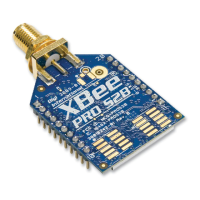XBee ZigBee networks End Device operation
XBee/XBee-PRO ZigBee RF Modules User Guide 50
Attempts to enter low power modes
These behaviors are configurable using the following commands:
Parent connectivity
The XBee ZB end device sends regular poll transmissions to its parent when it is awake. These poll transmissions
query the parent for any new received data packets. The parent always sends a MAC layer acknowledgment back
to the end device. The acknowledgment indicates whether the parent has data for the end device or not.
If the end device does not receive an acknowledgment for three consecutive poll requests, it considers itself
disconnected from its parent and will attempt to discover and join a valid ZigBee network. See Managing End
Devices on page 88 for details.
Resetting the End Device
When the end device is reset or power cycled, if the orphan scan successfully locates a parent, the end device
then checks its PAN ID, operating channel and stack profile against the network configuration settings (ID, SC,
ZS). It also verifies the saved security policy is valid based on the security configuration commands (EE, KY). If the
end device's PAN ID, operating channel, stack profile, or security policy is invalid, the end device will leave the
network and attempt to join a new network based on its network joining command values.
To prevent the end device from leaving an existing network, the WR command should be issued after all network
joining commands have been configured in order to retain these settings through power cycle or reset events.
Leaving a network
There are a couple of mechanisms that will cause the router to leave its current PAN and attempt to discover and
join a new network based on its network joining parameter values. These include the following:
The ID command changes such that the current 64-bit PAN ID is invalid.
The SC command changes such that the current operating channel (CH) is not included in the channel mask.
The ZS or any of the security command values change.
The NR0 command is issued to cause the end device to leave.
The NR1 command is issued to send a broadcast transmission, causing all devices in the network to leave and
migrate to a different channel.
The commissioning button is pressed four times or the CB command is issued with a parameter of 4.
The end device's parent is powered down or the end device is moved out of range of the parent such that the
end device fails to receive poll acknowledgment messages.
Changes to command values only take effect when changes are applied (AC or CN commands).
Command Description
D5 Enables the Associate LED functionality.
LT Sets the Associate LED blink time when joined. Default is two blinks per second (end devices).
SM, SP, ST, SN, SO Parameters that configure the sleep mode characteristics. See Managing End Devices on page 88 for
details.

